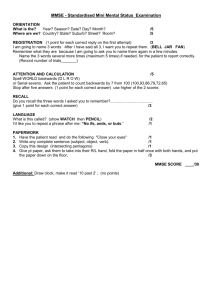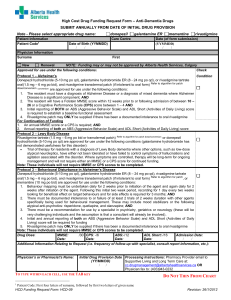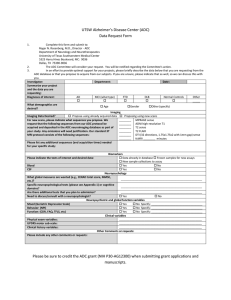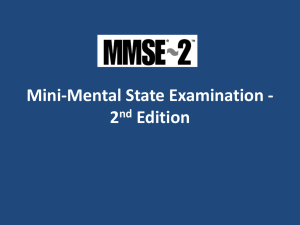Introducing a methodology to use ADL outcomes in the assessment
advertisement
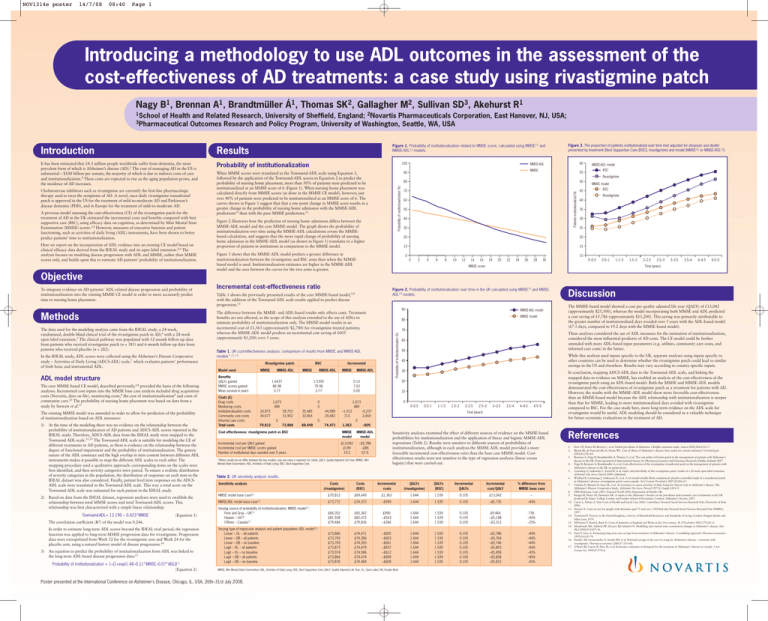
NOV1314e poster 14/7/08 08:40 Page 1 Introducing a methodology to use ADL outcomes in the assessment of the cost-effectiveness of AD treatments: a case study using rivastigmine patch Nagy B1, Brennan A1, Brandtmüller Á1, Thomas SK2, Gallagher M2, Sullivan SD3, Akehurst R1 1School of Health and Related Research, University of Sheffield, England; 2Novartis Pharmaceuticals Corporation, East Hanover, NJ, USA; Outcomes Research and Policy Program, University of Washington, Seattle, WA, USA 3Pharmaceutical Figure 1. Probability of institutionalization related to MMSE score, calculated using MMSE11 and MMSE-ADL13 models. Results It has been estimated that 24.3 million people worldwide suffer from dementia, the most prevalent form of which is Alzheimer’s disease (AD).1 The cost of managing AD in the US is substantial – $100 billion per annum, the majority of which is due to indirect costs of care and institutionalization.2 These costs are expected to rise as the aging population grows, and the incidence of AD increases. Probability of institutionalization A previous model assessing the cost-effectiveness (CE) of the rivastigmine patch for the treatment of AD in the UK estimated the incremental costs and benefits compared with best supportive care (BSC), using efficacy data on cognition, as determined by Mini Mental State Examination (MMSE) scores.3,4 However, measures of executive function and patient functioning, such as activities of daily living (ADL) instruments, have been shown to better predict patients’ time to institutionalization. Here we report on the incorporation of ADL evidence into an existing CE model based on clinical efficacy data derived from the IDEAL study and its open label extension.5,6 The analysis focuses on modeling disease progression with ADL and MMSE, rather than MMSE scores only, and builds upon this to estimate AD patients’ probability of institutionalization. 60 MMSE-ADL MMSE 90 When MMSE scores were translated to the Townsend-ADL scale using Equation 1, followed by the application of the Townsend-ADL scores to Equation 2 to predict the probability of nursing home placement, more than 50% of patients were predicted to be institutionalized at an MMSE score of 6 (Figure 1). When nursing home placement was calculated directly from MMSE scores (as done in the MMSE CE model), however, just over 40% of patients were predicted to be institutionalized at an MMSE score of 6. The curves shown in Figure 1 suggest that that a one point change in MMSE score results in a greater change in the probability of nursing home admission with the MMSE-ADL predictions13 than with the pure MMSE predictions.11 MMSE-ADL model BSC 55 Rivastigmine Probability of institutionalization (%) Cholinesterase inhibitors such as rivastigmine are currently the first-line pharmacologic therapy used to treat the symptoms of AD. A novel, once-daily rivastigmine transdermal patch is approved in the US for the treatment of mild-to-moderate AD and Parkinson’s disease dementia (PDD), and in Europe for the treatment of mild-to-moderate AD. 100 Figure 3. The proportion of patients institutionalized over time (not adjusted for dropouts and death) presented by treatment (Best Supportive Care [BSC], rivastigmine) and model (MMSE11 or MMSE-ADL13). Figure 2 illustrates how the prediction of nursing home admission differs between the MMSE-ADL model and the core MMSE model. The graph shows the probability of institutionalization over time using the MMSE-ADL calculations versus the MMSEbased calculation, and suggests that the more rapid change of probability of nursing home admission in the MMSE-ADL model (as shown in Figure 1) translates to a higher proportion of patients in institutions in comparison to the MMSE model. 80 50 70 45 Patients institutionalized (%) Introduction 60 50 40 30 Rivastigmine 40 35 30 25 20 20 10 15 Figure 3 shows that the MMSE-ADL model predicts a greater difference in institutionalization between the rivastigmine and BSC arms than when the MMSEbased model is used. Institutionalization estimates are higher in the MMSE-ADL model and the area between the curves for the two arms is greater. 0 MMSE model BSC 10 0 2 4 6 8 10 12 14 16 18 20 22 24 26 28 30 0–0.5 0.5–1 1–1.5 MMSE score 1.5–2 2–2.5 2.5–3 3–3.5 3.5–4 4–4.5 4.5–5 Time (years) Objective Methods The data used for the modeling analysis came from the IDEAL study, a 24-week, randomized, double-blind clinical trial of the rivastigmine patch in AD,6 with a 28-week open label extension.5 The clinical pathway was populated with 12-month follow-up data from patients who received rivastigmine patch (n = 383) and 6-month follow-up data from patients who received placebo (n = 282). In the IDEAL study, ADL scores were collected using the Alzheimer’s Disease Cooperative study – Activities of Daily Living (ADCS-ADL) scale,7 which evaluates patients’ performance of both basic and instrumental ADL. ADL model structure The core MMSE-based CE model, described previously,3,4 provided the basis of the following analyses. Incremental cost inputs into the MMSE base case analysis included drug acquisition costs (Novartis, data on file), monitoring costs,8 the cost of institutionalization9 and costs of community care.10 The probability of nursing home placement was based on data from a study by Stewart et al.11 The existing MMSE model was amended in order to allow for prediction of the probability of institutionalization based on ADL measures: 1) 2) At the time of the modeling there was no evidence on the relationship between the probability of institutionalization of AD patients and ADCS-ADL scores reported in the IDEAL study. Therefore, ADCS-ADL data from the IDEAL study were mapped to the Townsend ADL-scale.12,13 The Townsend-ADL scale is suitable for modeling the CE of different treatments in AD patients, as there is evidence on the relationship between the degree of functional impairment and the probability of institutionalization. The generic nature of the ADL construct and the high overlap in item content between different ADL instruments makes it possible to map the different ADL scales to each other. The mapping procedure used a qualitative approach: corresponding items on the scales were first identified, and then severity categories were paired. To ensure a realistic distribution of severity categories in the population, the distribution of responses on each item in the IDEAL dataset was also considered. Finally, patient level item responses on the ADCSADL scale were translated to the Townsend-ADL scale. This way a total score on the Townsend-ADL scale was estimated for each patient in the IDEAL study. Based on data from the IDEAL dataset, regression analyses were used to establish the relationship between total MMSE scores and total Townsend-ADL scores. This relationship was best characterized with a simple linear relationship: Townsend-ADL= 13.196 – 0.423*MMSE The correlation coefficient (R2) (Equation 1) of the model was 0.246. In order to estimate long-term ADL scores beyond the IDEAL trial period, the regression function was applied to long-term MMSE progression data for rivastigmine. Progression data were extrapolated from Week 52 for the rivastigmine arm and Week 24 for the placebo arm, using a natural history model of disease progression.14 3) An equation to predict the probability of institutionalization from ADL was linked to the long-term ADL-based disease progression data:13 Probability of institutionalization = 1–[1+exp(1.48–0.11*MMSE–0.07*ADL)]–1 (Equation 2) Incremental cost-effectiveness ratio Figure 2. Probability of institutionalization over time in the UK calculated using MMSE11 and MMSEADL13 models. Table 1 shows the previously presented results of the core MMSE-based model,3,4 with the addition of the Townsend-ADL scale results applied to predict disease progression.13 90 The difference between the MMSE- and ADL-based results only affects costs. Treatment benefits are not affected, as the scope of this analysis extended to the use of ADLs to estimate probability of institutionalization only. The MMSE model results in an incremental cost of £1,363 (approximately $2,700) for rivastigmine-treated patients; whereas the MMSE-ADL model predicts an incremental cost saving of £605 (approximately $1,200) over 5 years. Model used MMSE Benefits QALYs gained MMSE scores gained Mean survival in years Costs (£) Drug costs Monitoring costs Institutionalization costs Community care costs Informal care costs Total costs MMSE-ADL BSC MMSE 1.6437 86.98 3.77 MMSE-ADL 35,485 33,964 73,866 69,449 –1,512 713 74,471 1,363 0 50 The MMSE-based model showed a cost per quality adjusted life year (QALY) of £13,042 (approximately $25,500), whereas the model incorporating both MMSE and ADL predicted a cost saving of £5,786 (approximately $11,200). This saving was primarily attributable to the greater number of institutionalized days avoided over 5 years with the ADL-based model (67.5 days, compared to 19.2 days with the MMSE-based model). While this analysis used inputs specific to the UK, separate analyses using inputs specific to other countries can be used to determine whether the rivastigmine patch could lead to similar savings in the US and elsewhere. Results may vary according to country-specific inputs. 40 30 10 0 1,673 489 44,989 29,482 Discussion These analyses considered the use of ADL measures for the estimation of institutionalization, considered the most influential predictor of AD costs. The CE model could be further amended with more ADL-based input parameters (e.g. utilities, community care costs, and informal care costs) in the future. 60 20 0.10 7.02 0.00 0 0 39,752 31,952 0 70,812 MMSE 1.5392 79.96 3.77 1,673 489 33,973 34,677 Incremental MMSE-ADL MMSE model 70 Table 1. UK cost-effectiveness analysis: comparison of results from MMSE and MMSE-ADL models*.11,13 Rivastigmine patch MMSE-ADL model 80 Probability of institutionalization (%) To integrate evidence on AD patients’ ADL-related disease progression and probability of institutionalization into the existing MMSE CE model in order to more accurately predict time to nursing home placement. 0–0.5 0.5–1 1–1.5 –5,237 2,469 1.5–2 2–2.5 2.5–3 3–3.5 3.5–4 4–4.5 4.5–5 Time (years) 0 In conclusion, mapping ADCS-ADL data to the Townsend-ADL scale, and linking the mapped data to evidence on MMSE, has enabled an analysis of the cost-effectiveness of the rivastigmine patch using an ADL-based model. Both the MMSE and MMSE-ADL models demonstrated the cost-effectiveness of rivastigmine patch as a treatment for patients with AD. However, the results with the MMSE-ADL model show more favorable cost-effectiveness than an MMSE-based model because the ADL relationship with institutionalization is steeper than that for MMSE, leading to more institutionalized days avoided with rivastigmine compared to BSC. For the case study here, more long-term evidence on the ADL scale for rivastigmine would be useful. ADL modeling should be considered as a valuable technique for future economic evaluations in the treatment of AD. –605 Cost effectiveness: rivastigmine patch vs BSC MMSE model MMSE-ADL model Incremental cost per QALY gained Incremental cost per MMSE scores gained Number of institutional days avoided over 5 years £13,042 £194 19.2 –£5,786 –£86 67.5 Sensitivity analyses examined the effect of different sources of evidence on the MMSE-based probabilities for institutionalization and the application of linear and logistic MMSE-ADL regressions (Table 2). Results were sensitive to different sources of probabilities of institutionalization, although in each analysis the MMSE-ADL model provided a more favorable incremental cost-effectiveness ratio than the base case MMSE model. Costeffectiveness results were not sensitive to the type of regression analyses (linear versus logistic) that were carried out. *Where results do not differ between the two models, only one value is reported, for clarity. QALY, Quality Adjusted Life Year; MMSE, Mini Mental State Examination; ADL, Activities of Daily Living; BSC, Best Supportive Care References 1. 2. 3. 4. 5. Table 2. UK sensitivity analysis results. Sensitivity analysis MMSE model base case11 MMSE-ADL model base case13 6. Costs (rivastigmine) Costs (BSC) Incremental costs QALYs (rivastigmine) QALYs (BSC) Incremental QALYs Incremental cost/QALY % difference from MMSE base case £70,812 £69,449 £1,363 1.644 1.539 0.105 £13,042 – £73,772 £74,372 –£599 1.644 1.539 0.105 –£5,735 –44% Varying source of probability of institutionalization; MMSE model11: Fenn and Gray – UK15 Hauber – US16 O’Brien – Canada17 £66,352 £81,928 £79,484 £65,362 £82,472 £79,830 £990 –£543 –£346 1.644 1.644 1.644 1.539 1.539 1.539 0.105 0.105 0.105 £9,466 –£5,198 –£3,312 73% –40% –25% Varying type of regression analysis and patient population; ADL model13: Linear – OL – all patients Linear – DB – all patients Linear – DB – no baseline Logit – OL – all patients Logit – OL – no baseline Logit – DB – all patients Logit – DB – no baseline £73,866 £73,793 £73,793 £73,873 £73,974 £73,864 £73,876 £74,471 £74,396 £74,393 £74,479 £74,586 £74,474 £74,484 –£605 –£603 –£601 –£607 –£612 –£609 –£608 1.644 1.644 1.644 1.644 1.644 1.644 1.644 1.539 1.539 1.539 1.539 1.539 1.539 1.539 0.105 0.105 0.105 0.105 0.105 0.105 0.105 –£5,786 –£5,764 –£5,746 –£5,803 –£5,858 –£5,828 –£5,815 –44% –44% –44% –44% –45% –45% –45% 8. 9. 10. 11. MMSE, Mini Mental State Examination; ADL, Activities of Daily Living; BSC, Best Supportive Care; QALY, Quality Adjusted Life Year; OL, Open Label; DB, Double Blind Poster presented at the International Conference on Alzheimer's Disease, Chicago, IL, USA, 26th–31st July 2008. 7. 12. 13. 14. 15. 16. 17. Ferri CP, Prince M, Brayne C, et al. Global prevalence of dementia: a Delphi consensus study. Lancet 2005;366:2112–7. Bloom BS, de Pouvourville N, Straus WL. Cost of illness of Alzheimer’s disease: how useful are current estimates? Gerontologist 2003;43:158–64. Brennan A, Nagy B, Brandtmuller A, Thomas S, et al. The cost-utility of Exelon patch in the management of patients with Alzheimer’s disease in the UK. Poster presented at International Society for Pharmacoeconomics and Outcomes Research; Dublin, Ireland; 2007. Nagy B, Brennan A, Brandtmuller A, et al. Cost-effectiveness of the rivastigmine transdermal patch in the management of patients with Alzheimer’s disease in the UK (in preparation). Grossberg G, Sadowsky C, Forstl H, et al. Safety and tolerability of the rivastigmine patch: results of a 28-week open-label extension. Alzheimer Dis Assoc Disord 2008; submitted. Winblad B, Cummings J, Andreasen N, et al. A six-month double-blind, randomized, placebo-controlled study of a transdermal patch in Alzheimer’s disease—rivastigmine patch versus capsule. Int J Geriatr Psychiatry 2007;22:456–67. Galasko D, Bennett D, Sano M, et al. An inventory to assess activities of daily living for clinical trials in Alzheimer’s disease. The Alzheimer’s Disease Cooperative Study. Alzheimer Dis Assoc Disord 1997;11 Suppl 2:S33–9. NHS Reference Costs 2003, National Tariff 2004, Department of Health, UK. Knapp M, Prince M. Dementia UK: A report to the Alzheimer’s Society on the prevalence and economic cost of dementia in the UK produced by King’s College London and London School of Economics. London: Alzheimer’s Society; 2007. Curtis L, Netten A. Unit Costs of Health and Social Care 2006. Canterbury: Personal Social Services Research Unit, University of Kent 2006. Stewart A. Costs of care for people with dementia aged 75 and over. 1303/2nd edn: Personal Social Services Research Unit (PSSRU); 1997. Townsend P. Poverty in the United Kingdom, a Survey of Household Resources and Standards of Living. London: Penguin Books and Allen Lane; 1979. McNamee P, Bond J, Buck D. Costs of dementia in England and Wales in the 21st century. Br J Psychiatry 2001;179:261–6. Mendiondo MS, Ashford JW, Kryscio RJ, Schmitt FA. Modelling mini mental state examination changes in Alzheimer’s disease. Stat Med 2000;19:1607–16. Fenn P, Gray A. Estimating long-term cost savings from treatment of Alzheimer’s disease. A modelling approach. Pharmacoeconomics 1999;16:165–74. Hauber AB, Gnanasakthy A, Snyder EH, et al. Potential savings in the cost of caring for Alzheimer’s disease – treatment with rivastigmine. Pharmacoeconomics 2000;17:351–60. O’Brien BJ, Goeree R, Hux M, et al. Economic evaluation of donepezil for the treatment of Alzheimer’s disease in Canada. J Am Geriatr Soc 1999;47:570–8.
